In an ever-evolving business landscape, your organization's operating model is the key to success. Crafting the blueprint for tomorrow is about adapting to change & thriving in dynamic markets. In this blog, we'll explore the critical components of a future-ready operating model, offering you insights to navigate today's complexities & build a successful future. So let’s go
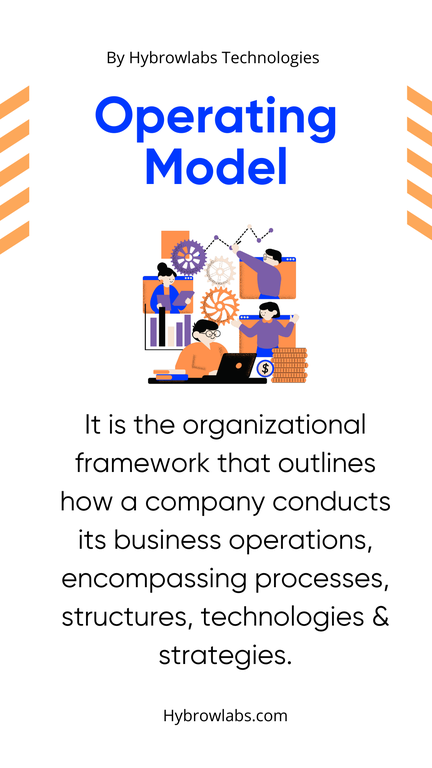
Understanding Operating Model:
An operating model is a framework that outlines how an organization conducts its business & operational activities. It defines the key processes, structures, technologies & strategies that enable an organization to deliver value to its customers, manage resources efficiently & achieve its strategic objectives. Essentially, it's the blueprint that guides how an organization operates daily.
The Dynamic Nature of Business Environments:
Business environments today are marked by constant change and evolution. Technological advancements, shifting consumer preferences, economic fluctuations & global events can disrupt markets & industries. The dynamic nature of business environments highlights the need for organizations to be agile & adaptive. Those that can quickly respond to change are better positioned for long-term success.
Adapting to a dynamic business environment requires organizations to:
1. Anticipate Change:
Proactively monitor industry trends & anticipate changes that may impact their operations.
2. Innovate:
Embrace innovation & stay open to new ideas, technologies & strategies to remain competitive.
3. Flexibility:
Build organizational structures & processes that can pivot & adjust in response to changing circumstances.
4. Customer-Centricity:
Continuously listen to & understand customer needs, adjusting products & services accordingly.
The Impact of the Operating Model on Business Success:
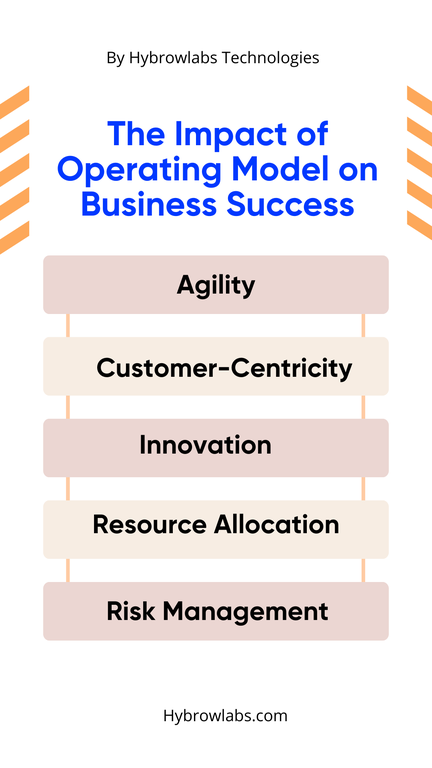
The operating model plays a pivotal role in determining an organization's ability to navigate the dynamic business landscape successfully. Its impact is profound in several ways:
1. Agility:
A well-structured operating model enables an organization to be agile & respond swiftly to changing market conditions. It facilitates the adoption of new processes & technologies as needed.
2. Innovation:
A forward-thinking operating model can foster a culture of innovation, encouraging employees to seek out creative solutions to emerging challenges.
3. Resource Allocation:
It ensures that resources are allocated efficiently & in alignment with strategic goals, allowing an organization to invest in areas that promise the greatest returns.
4. Risk Management:
An effective operating model can identify potential risks & provide mechanisms to mitigate them, enhancing the organization's resilience in the face of unexpected disruptions.
5. Customer-Centricity:
By aligning with customer needs & preferences, the operating model can enhance the delivery of products & services, resulting in greater customer satisfaction & loyalty.
Key Components of a Future-Ready Operating Model:
A. Strategic Alignment
a) Aligning the Operating Model with the Business Strategy:
The operating model should be in sync with the overarching business strategy. This alignment ensures that every operational aspect contributes to the achievement of strategic goals.
b) Importance of a Shared Vision:
A shared vision among all stakeholders, from leadership to employees, is essential for effective strategic alignment. It fosters a common understanding of the organization's purpose and direction.
B. Agile Processes
a) Adopting Agile Methodologies:
Embracing agile methodologies like Scrum or Kanban can enhance the organization's ability to respond rapidly to changes in the market. It promotes iterative development & constant improvement.
b) Responding to Changing Customer Needs:
Agile processes allow organizations to be more customer-centric by adapting quickly to evolving customer demands & preferences.
C. Technology Integration
a) Leveraging Technology for Efficiency:
Integrating technology into the operating model improves efficiency. This includes implementing software, tools, and systems that streamline processes & reduce manual work.
b) The Role of Automation and Digital Transformation:
Automation & digital transformation play a crucial role in modernizing the operating model. They can lead to cost savings, improved productivity & better customer experiences.
D. Talent and Culture
a) Building a Culture of Innovation:
Fostering a culture of innovation is vital for staying competitive. It encourages employees to think creatively, propose new ideas & experiment with different solutions.
b) Skills and Capabilities Required for the Future:
Identifying and developing the skills & capabilities that will be in demand in the future is crucial. Training & upskilling employees to meet these demands is part of this component.
E. Data-Driven Decision-Making
a) Harnessing the Power of Data and Analytics:
Data and analytics provide valuable insights into customer behavior, market trends & operational performance. Leveraging data is key to making informed decisions.
b) Making Informed Decisions:
Making decisions based on data rather than gut feeling or tradition can lead to more accurate & effective choices, whether in product development, marketing, or resource allocation.
Steps to Design a Future-Ready Operating Model:
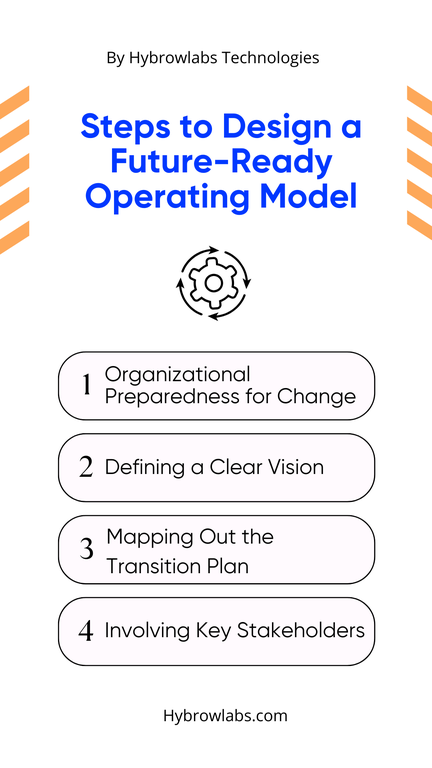
1. Assessing Your Organization's Readiness for Change
Before embarking on the journey to craft a future-ready operating model, it's essential to assess the organization's readiness for change. This involves evaluating the current culture, existing processes & the level of adaptability among employees. Identifying areas that may resist change or require special attention is crucial.
2. Defining a Clear Vision
A clear & compelling vision serves as the guiding light for the transformation. It should outline what the organization aspires to achieve with the new operating model. This vision should align with the overall business strategy & be communicated effectively to all stakeholders. It helps create a shared understanding of the desired future state.
3. Mapping Out the Transition Plan
Developing a comprehensive transition plan is the practical roadmap for implementing the future-ready operating model. This plan should detail the steps, timelines, resource allocation & milestones required to achieve the vision. It is essential to break down the transformation into manageable phases to ensure a smooth transition.
4. Involving Key Stakeholders
Successful transformation depends on the involvement and buy-in of key stakeholders. This includes leadership, employees at all levels, customers & partners. Engaging these stakeholders in the design & implementation process ensures that their perspectives are considered, and it can help address concerns & resistance to change.
Key steps in involving stakeholders include communication strategies, change management efforts & creating feedback loops for continuous improvement.
Implementing and Managing Change:
A. Strategies for a Smooth Transition
To ensure a smooth transition when implementing a future-ready operating model, organizations should:
- Break the transition into manageable phases with clear milestones.
- Communicate transparently & consistently with all stakeholders.
- Provide training & development opportunities for employees.
- Set & track performance metrics to measure progress.
B. Addressing Resistance to Change
Resistance to change is a common challenge during transformations. Strategies to address resistance include:
- Open and honest communication to understand & address concerns.
- Empower change champions within the organization.
- Offer incentives & rewards for those embracing change.
- Educate employees about the reasons for change & provide support.
C. The Role of Leadership in Driving the Change
Leadership plays a critical role in driving and sustaining change within an organization:
- Leaders should lead by example, embodying the desired behaviors.
- Effective communication of the vision, rationale & expected outcomes is essential.
- Empower employees to contribute to the change process.
- Provide continuous support & resources to help employees adapt.
- Leaders should be adaptable and open to feedback & changes.
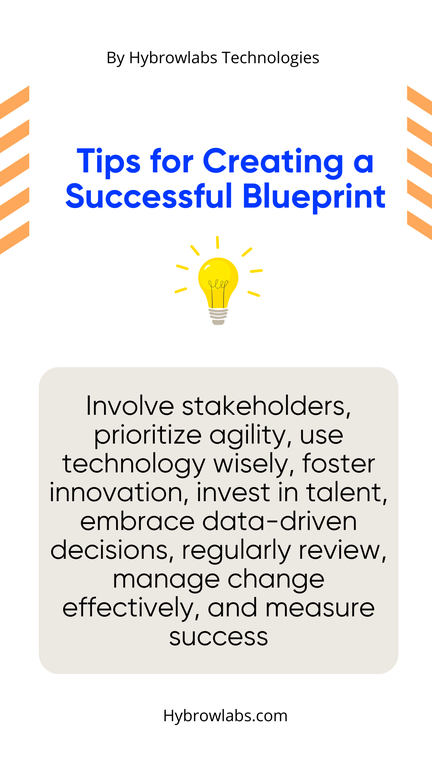
1. Start with a Clear Vision:
A clear & compelling vision acts as a north star for your organization. It defines the desired future state & ensures that everyone understands where the organization is headed.
2. Involve Diverse Perspectives:
Diverse perspectives provide a holistic view of the challenges & opportunities. Engage with employees, customers & partners to gather valuable insights, ensuring your blueprint is well-informed.
3. Prioritize Agility:
In a rapidly changing business environment, designing your blueprint with flexibility in mind is essential. Your operating model should be able to adapt quickly to changing market conditions & emerging opportunities.
4. Leverage Technology Wisely:
Choose and integrate technology solutions that align with your strategic objectives. Technology should enhance efficiency, automation & innovation, not complicate operations.
5. Promote a Culture of Innovation:
Encourage a work culture that values & rewards innovation. Empower employees to contribute new ideas, experiment with different approaches & challenge the status quo.
6. Invest in Talent Development:
Identify the skills and capabilities your organization will need in the future. Invest in training & development programs to upskill your workforce, ensuring they have the competencies required for the new operating model.
Conclusion:
In an ever-evolving business landscape, the ability to adapt & innovate is the key to sustained success. Crafting a blueprint for a future-ready operating model is not just a strategic choice; it's a necessity. As organizations face dynamic market conditions, changing customer preferences & emerging technologies, the operating model serves as the foundation that guides an organization through these challenges. Don't wait; start your proactive digital transformation journey today! And here in this journey, Hybrowlabs can be your trusted navigator. Join us as we undertake this exciting adventure toward a brighter & more innovative future. The possibilities are endless & they all begin with a single step.
Are you ready to transform your business? Let's get started today!
FAQ:
1. What is an operating model?
An operating model is a framework that defines how an organization conducts its business & operational activities. It outlines key processes, structures, technologies & strategies to deliver value, manage resources & achieve strategic objectives.
2. Why is having a well-defined operating model important?
A well-defined operating model is vital because it enhances efficiency, aligns operations with the business strategy & enables an organization to adapt to changing environments. It also helps manage risks, allocate resources effectively & maintain quality & consistency in delivering products or services.
3. How can an organization adapt its operating model to a dynamic business environment?
To adapt to a dynamic business environment, organizations should focus on strategic alignment, agility, technology integration, talent development & data-driven decision-making. These components help organizations remain flexible & responsive to changes.
4. What are the key steps to design a future-ready operating model?
The key steps include assessing the organization's readiness for change, defining a clear vision, mapping out a transition plan & involving key stakeholders. These steps ensure a well-structured & collaborative approach to crafting a future-ready model.
5. How can organizations manage resistance to change when implementing a new operating model?
To address resistance to change, organizations should maintain open communication, empower change champions, offer incentives & provide education and support. Change management strategies can help employees embrace the new model more smoothly.



.png)


a3dc85.jpg)

.jpg)
fd8f11.png)
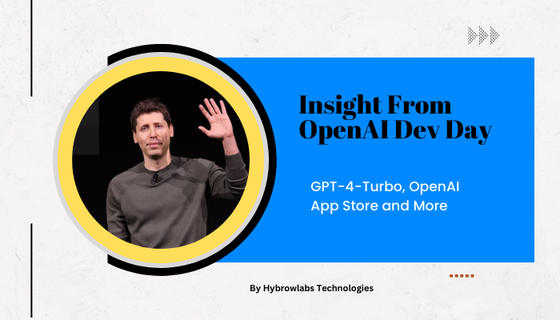
.jpg)
.jpg)